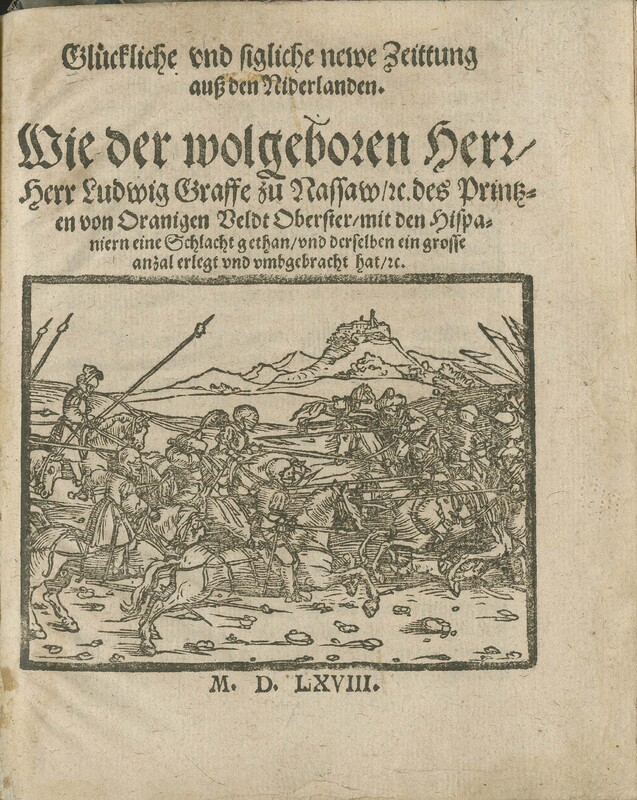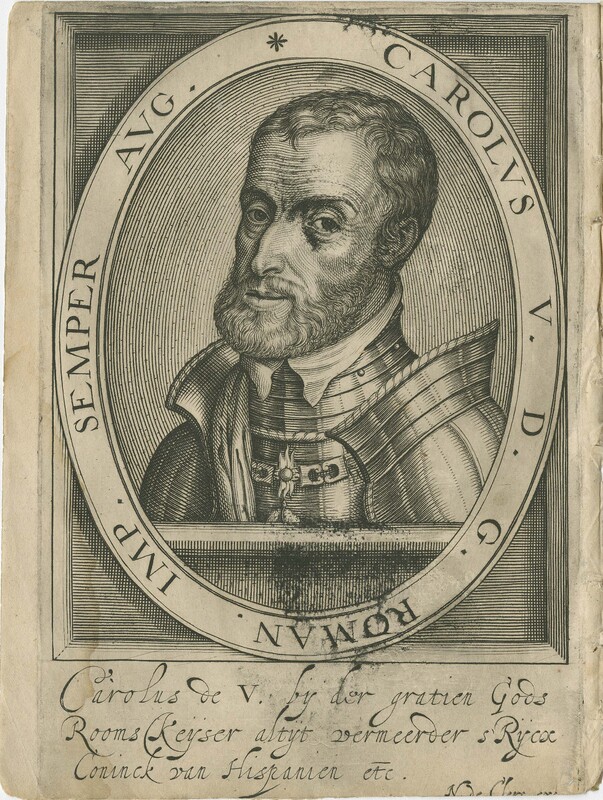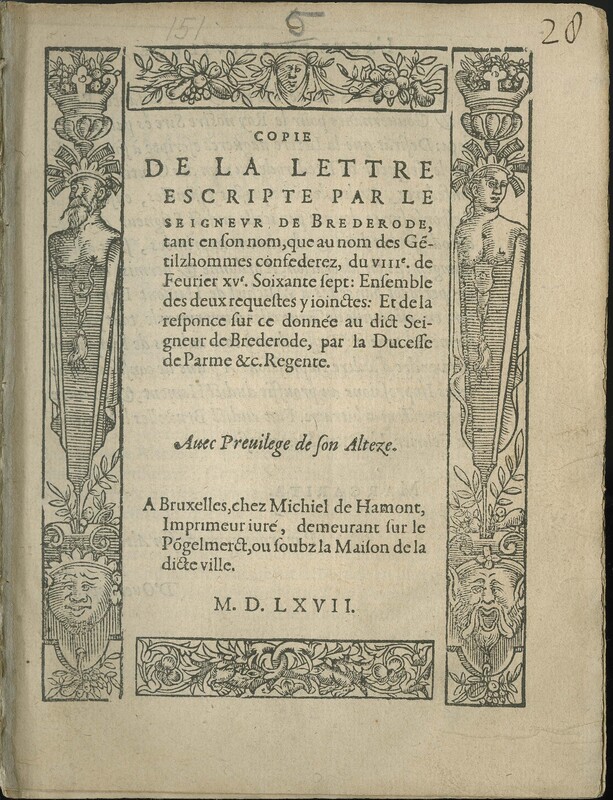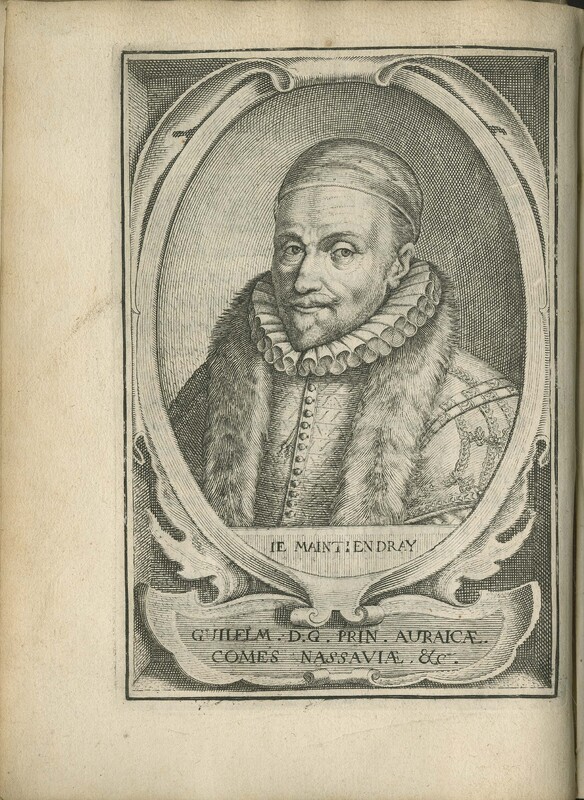The Revolt against the Spanish Rulers (1556-1648): The Actors
The Michigan collection begins with the period of the revolt of the Seventeen Provinces of the Netherlands against their Spanish rulers (1556-1648). In brief, the Seventeen Provinces were the Imperial states in the Low Countries under the control of the Holy Roman Empire's House of Habsburg in the sixteenth century: they were originally called the Habsburg Netherlands. To be precise, the rule began in 1482, when the last Valois-Burgundy ruler, Mary Dutchess of Burgundy, the wife of Maximilian I of Austria, died. Their grandson, Charles, who was born in the Habsburg Netherlands, succeeded them as Holy Roman Emperor and Archduke of Austria in 1519, uniting all these 17 provinces under his rule by the year 1543. Broadly, the Seventeen Provinces included the modern Netherlands, Belgium, Luxembourg, and two northern departments of France: Nord and Pas-de-Calais.
In this section, the pamphlets document the relationship between the local nobility of the Low Countries and the Spanish authorities; the impact of the Spanish Inquisition on the Provinces; and the rise of William I, Prince of Orange, as leader of the insurrection; sieges and military battles; assassinations and executions; religious controversies among the Provinces as they tried to unify against their common enemy; the abjuration in 1581 by the seven northern provinces (henceforth known as the United Provinces of the Netherlands), of the authority of Spain; and political alliances with other European nations.
Opening this pamphlet is a copperplate engraving depicting the bust portrait of Emperor Charles V (1500-1558) in full armor. Around an oval frame is the following Latin inscription: "Carolus V. D. G. (dei gratia: "by the grace of God") Romanus Imperator Semper Augustus." An engraved caption in Dutch cursive paraphrases this Latin inscription. The pamphlet records Charles's incorporation of the lands of Holland and Utrecht into those territories in the Low Countries that the Emperor had inherited from his forebears.
Born and raised in Ghent, Charles was heir to four of Europe’s dynasties, including the House of Burgundy and the Habsburgs of Austria. Through purchase, marriage, and war, his forebears united most of the Low Countries, and he himself conquered Friesland, Groningen, and Gelderland, the last of the seventeen provinces to be added. In 1555 he turned over his Dutch possessions to his son Philip II (1527-1598). Philip was born in Spain and spent very little time in the Low Countries. He had no fond feelings for these lands and people. He stayed in Brussels, the seat of the Habsburg Dutch empire, for only a few years, before returning to the Spanish peninsula.
This title page is framed by four ornamental woodcuts representing various cornucopian motifs: the left and right woodcuts respectively depict male and female column-like figures, each topped with a crown full of fruits and plants; the top and bottom woodcuts are decorated with fruits, ivy, and other plants. The woodcut encloses a title in French describing the content of this pamphlet: a copy of Hendrik van Brederode's letter to Margaret of Austria, including Margaret's reply.
Philip II had installed his half-sister, Margaret of Austria, Duchess of Parma (1522-1586), as regent of the Netherlands in 1559. This pamphlet contains the letter that Henrik van Brederode (1531-1568), a convert to the Reformed faith and spokesman for a group of nobles resisting Spanish domination, wrote to Margaret of Austria. Essentially, the letter asks for relief from the Spanish Inquisition. In response, Philip sent the notorious Duke of Alba at the head of thousands of Spanish troops to deal with the heretics and rebels of the Netherlands.
Full-page copperplate engraving depicting a bust portrait of William I, Prince of Orange, within an oval frame. With a beard, and wearing a cap, William is elegantly dressed according to the canons of the aristocracy of the period, including the so-called "lechuguilla" ("little lettuce)", or "ruff" in English, which is a decorative removable pleated collar of Spanish origin that became popular in Europe in the sixteenth and seventeenth centuries. He also wears a fur scarf. At the bottom of the oval frame is the French motto, "Ie Maintiendray", or in modern spelling, "Je Maintiendrai "(I will maintain), taken from the coat of arms of the Orange-Nassau family. On a cartouche below is the Latin inscription, Gulielmus D. G. (dei gratia: "by the grace of God") Princeps Auraicae. Comes Nassaviae, &c. This engraving is attributed to Johann Ammon (d. 1656).
In this Elzevier edition of 1621, this portrait illustrates Johannes van Meurs's biography of William I, Prince of Orange (1533-1584), part of his larger De rebus toto Belgio (History of Belgium). William originally served at the court of Margaret of Parma but by 1567 had joined the rebel resistance. As one of the most prominent and capable politicians of the Netherlands, he emerged as its leader and was acknowledged as "stadholder" (de facto head of state) in 1572. He is known as the Father of the Fatherland.
The title page summarizes the content of this pamphlet: it is William I of Orange's defense, written in French, against the proscription against him issued by the King of Spain, Philip II.
In 1580 Holland and Zeeland formally abjured their allegiance to Philip II. Nearly at the same time, Philip issued a proscription against William I, Prince of Orange, and a big reward for capturing him "dead or alive." William was assassinated in 1584 by a Catholic Frenchman who was a supporter of Philip II.

The Revolt against the Spanish Rulers (1556-1648): Battles, Sieges, and Treaties




